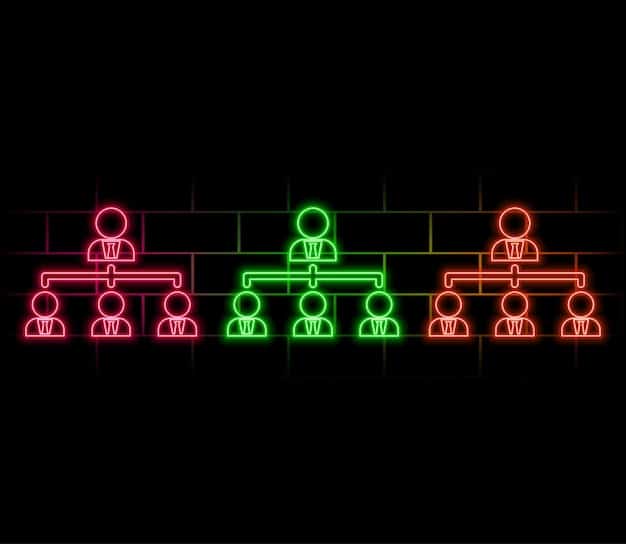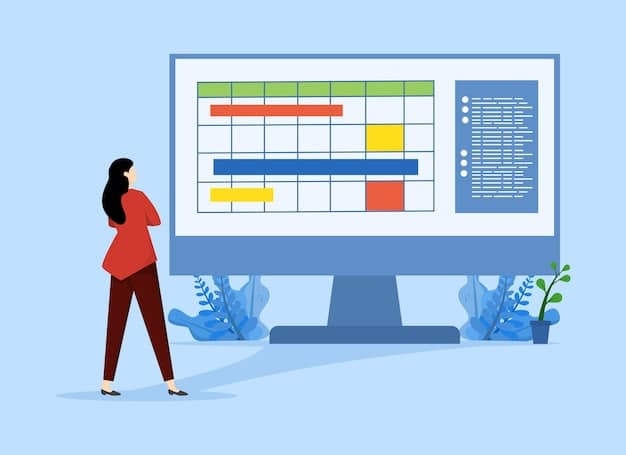US Remote Team Accountability: Clear Expectations and Performance Measurement

US Remote Team Accountability involves establishing clear expectations, implementing effective communication channels, utilizing performance measurement tools, and fostering a culture of trust to ensure remote teams achieve organizational goals.
In today’s dynamic work environment, US Remote Team Accountability: Establishing Clear Expectations and Measuring Performance is paramount for organizational success. Effectively managing remote teams requires a strategic approach that ensures every team member is aligned, productive, and accountable.
Understanding the Importance of Accountability in US Remote Teams
In the context of US remote teams, accountability is not merely about tracking tasks; it’s about creating a culture of ownership and responsibility. When team members feel accountable, they are more likely to take initiative, meet deadlines, and contribute to overall team success.
Accountability in remote teams transcends physical presence, focusing on outcomes, trust, and clear communication. Implementing effective accountability measures can significantly improve team performance, boost morale, and reduce the risk of project delays or failures.
Why Accountability Matters
Accountability is the cornerstone of any successful team, and it’s even more critical in remote settings where face-to-face interaction is limited. Here’s why:
- Enhances Productivity: Accountable team members are more likely to stay focused and deliver high-quality work.
- Builds Trust: When everyone is accountable, trust grows, leading to stronger team relationships.
- Improves Communication: Accountability requires clear communication of expectations, progress, and feedback.
Common Challenges in Remote Team Accountability
While accountability is vital, remote teams often face unique challenges in its implementation:
- Lack of Visibility: It can be difficult to monitor progress and ensure everyone is on track without regular in-person check-ins.
- Communication Barriers: Misunderstandings and delays in communication can hinder accountability.
- Isolation: Remote workers may feel disconnected, which can reduce their sense of accountability.
Establishing a robust accountability framework is essential to address these challenges and foster a productive remote work environment. Accountability ensures that each team member understands their roles, responsibilities, and how their contributions impact the team’s overall goals.
Setting Clear Expectations for US-Based Remote Teams
Setting clear expectations is the first step in establishing accountability within remote teams. Ambiguity can lead to confusion, frustration, and ultimately, reduced performance. Clearly defined roles, responsibilities, and goals provide a solid foundation for accountability.
When expectations are explicit, team members know exactly what is required of them, how their performance will be measured, and what the consequences are for not meeting those expectations. This clarity fosters a sense of ownership and motivates individuals to take responsibility for their work.
Defining Roles and Responsibilities
Each team member should have a clear understanding of their role and responsibilities. This includes:
- Job Descriptions: Detailed job descriptions outlining tasks, duties, and expectations.
- Role Clarification: Regular discussions to ensure everyone understands their responsibilities and how they fit into the team.
- Accountability Matrix: A matrix that clearly identifies who is responsible, accountable, consulted, and informed (RACI) for each task or project.

Establishing SMART Goals
Setting Specific, Measurable, Achievable, Relevant, and Time-bound (SMART) goals is crucial for driving accountability. SMART goals provide a clear roadmap and allow for effective performance tracking.
- Specific: Clearly define what needs to be achieved.
- Measurable: Establish metrics to track progress.
- Achievable: Set realistic goals that are within reach.
By setting SMART goals, remote teams can stay focused, track progress, and ensure they are working towards tangible outcomes. Regular check-ins and performance reviews can help monitor progress and make necessary adjustments to stay on track.
Implementing Effective Communication Strategies for Remote Teams
Transparent and open communication is key to driving accountability. In a remote setting, it’s essential to establish communication channels and protocols that ensure everyone stays informed and connected.
Effective communication fosters trust, reduces misunderstandings, and keeps team members aligned on goals and expectations. Regular check-ins, clear communication platforms, and documented processes are essential components of an accountability-driven communication strategy.
Utilizing Communication Tools
Leverage technology to facilitate communication and collaboration:
- Video Conferencing: Use tools like Zoom or Google Meet for regular team meetings and one-on-one check-ins.
- Instant Messaging: Utilize platforms like Slack or Microsoft Teams for quick communication and collaboration.
- Project Management Software: Use tools like Asana or Trello to track progress, assign tasks, and share updates.
Establishing Communication Protocols
Set clear guidelines for communication to ensure everyone is on the same page:
- Response Times: Define expectations for responding to emails and messages.
- Meeting Schedules: Establish a regular meeting schedule to keep everyone connected and informed.
- Feedback Loops: Create channels for providing and receiving feedback.
By establishing clear communication protocols and utilizing the right tools, remote teams can enhance collaboration, alignment, and accountability. Regular communication ensures that team members stay connected, informed, and engaged, fostering a culture of trust and transparency.

Measuring Performance and Providing Feedback
Regular performance measurement is essential for ensuring accountability. Establish clear metrics and processes for tracking progress and providing feedback. This allows you to identify areas where team members are excelling and areas where they need improvement.
Constructive feedback helps team members understand their performance, identify areas for growth, and stay motivated. Regular performance evaluations, coupled with open communication, create a continuous improvement loop that drives accountability and enhances overall team performance.
Key Performance Indicators (KPIs)
Identify relevant KPIs to measure performance:
- Task Completion Rate: Track the percentage of tasks completed on time and within budget.
- Project Milestones: Monitor progress against key project milestones.
- Customer Satisfaction: Measure customer satisfaction through surveys and feedback.
Performance Reviews
Conduct regular performance reviews to provide feedback and discuss progress:
- Frequency: Schedule reviews on a regular basis (e.g., quarterly or semi-annually).
- Format: Use a structured format to ensure reviews are consistent and fair.
- Feedback: Provide constructive feedback that is specific and actionable.
Performance reviews should focus on both achievements and areas for improvement, providing team members with a clear understanding of their performance and how they can continue to grow. By linking performance to accountability, teams can ensure that everyone is motivated to achieve their goals and contribute to overall success.
Fostering a Culture of Trust and Transparency
Trust is the foundation of any successful remote team. Without trust, accountability becomes a burden rather than a catalyst for growth. Transparency, open communication, and mutual respect are essential for building trust.
When team members trust each other, they are more likely to take risks, share ideas, and hold each other accountable. A culture of trust fosters a sense of psychological safety, where individuals feel comfortable expressing concerns, asking questions, and offering feedback without fear of reprisal.
Building Trust
Here are some strategies for building trust:
Clear communication is crucial for building trust and ensuring everyone is on the same page. Setting clear expectations, active listening, and transparent updates can significantly enhance team cohesion and productivity.
- Open Communication: Encourage open and honest communication.
- Reliability: Be reliable and follow through on commitments.
- Empathy: Show empathy and understanding towards team members.
Promoting Transparency
Transparency can be promoted in the following ways:
- Share Information: Share relevant information with the team.
- Involve Team Members: Involve team members in decision-making processes.
- Provide Context: Provide context for decisions and actions.
By fostering a culture of trust and transparency, US remote teams can create an environment where accountability thrives. When team members trust each other and have clear visibility into team activities, they are more likely to take ownership of their work and hold themselves and their colleagues accountable.
Tools and Technologies to Enhance Remote Team Accountability
Leveraging the right tools and technologies can significantly enhance remote team accountability. Project management software, communication platforms, and time-tracking tools are essential for monitoring progress, facilitating communication, and ensuring everyone is aligned.
These tools provide visibility into individual and team performance, allowing managers to track progress, identify bottlenecks, and provide timely feedback. By integrating these tools into daily workflows, remote teams can streamline processes, improve communication, and enhance overall accountability.
Project Management Software
Tools like Asana, Trello, and Jira can help with task management, progress tracking, and collaboration:
- Task Assignment: Assign tasks to team members with clear deadlines.
- Progress Tracking: Monitor progress and identify potential roadblocks.
- Collaboration: Facilitate collaboration and communication within the project.
Communication Platforms
Platforms like Slack and Microsoft Teams can enhance communication and collaboration:
- Instant Messaging: Enable quick and easy communication.
- Channels: Create channels for specific projects or topics.
- Video Conferencing: Facilitate video calls for meetings and check-ins.
By utilizing these tools effectively, remote teams can stay connected, track progress, and ensure everyone is accountable for their responsibilities. The right technology not only enhances productivity but also fosters a culture of transparency and trust, essential for successful remote team management.
| Key Point | Brief Description |
|---|---|
| 🎯 Clear Expectations | Defining roles and setting SMART goals. |
| 🗣️ Effective Communication | Using tools and protocols for transparency. |
| 📈 Performance Measurement | Tracking KPIs and providing feedback. |
| 🤝 Trust & Transparency | Building trust through open communication. |
Frequently Asked Questions
Accountability in a US remote team involves each team member taking ownership of their tasks and responsibilities. It includes meeting deadlines, delivering high-quality work, and being responsible for the outcomes of their actions within a virtual work environment.
To set clear expectations for a remote team, define roles and responsibilities clearly. Use SMART goals (Specific, Measurable, Achievable, Relevant, Time-bound) to provide a clear roadmap, and ensure everyone understands their tasks and how they contribute to the team’s goals.
Essential communication tools for remote team accountability include video conferencing (Zoom, Google Meet), instant messaging (Slack, Microsoft Teams), and project management software (Asana, Trello). These tools facilitate transparent communication, task tracking, and progress monitoring.
Performance in a remote team can be measured through Key Performance Indicators (KPIs), such as task completion rates and customer satisfaction. Regular performance reviews and feedback sessions help team members understand their progress and areas for improvement.
Trust and transparency are vital for remote team accountability because they foster a culture of ownership and psychological safety. When team members trust each other, they are more likely to take risks, share ideas, and hold each other accountable for their work.
Conclusion
In conclusion, implementing effective strategies for US Remote Team Accountability: Establishing Clear Expectations and Measuring Performance is essential for achieving organizational success. By setting clear expectations, fostering transparent communication, measuring performance regularly, and cultivating a culture of trust, organizations can empower their remote teams to thrive and achieve their full potential.





